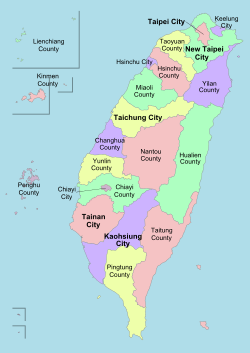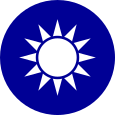
Back Área libre de la República de China Spanish Kawasan bebas Republik Tiongkok ID 台湾地区 Japanese 대만 지구 Korean တရုတ်သမ္မတနိုင်ငံ၏ လွတ်လပ်သောဧရိယာ Burmese Wolny obszar Republiki Chińskiej Polish Área livre da República da China Portuguese Свободная территория Китайской Республики Russian Free area of the Republic of China SIMPLE Çin Cumhuriyeti Özgür Alanı Turkish
This article has multiple issues. Please help improve it or discuss these issues on the talk page. (Learn how and when to remove these messages)
|
Taiwan Area Taiwan Area of the Republic of China 臺灣地區 中華民國臺灣地區 | |
|---|---|
 | |
| Largest cities | |
| Languages | |
| Ethnic groups | |
| Demonym(s) | |
| Area | |
• Total | 36,193 km2 (13,974 sq mi) |
| Population | |
• 2018 census | 23,681,968 |
• Density | 650/km2 (1,683.5/sq mi) |
| Currency | New Taiwan Dollar (TWD, NTD) |
| Time zone | UTC+08:00 (National Standard Time) |
| Date format | yyyy年mm月dd日 |
| Drives on | Right |
| Calling code | +886 |
| Internet TLD | .tw, .台灣, .台湾 |
| Taiwan Area | |||||||||||||||||||||||||||||||
|---|---|---|---|---|---|---|---|---|---|---|---|---|---|---|---|---|---|---|---|---|---|---|---|---|---|---|---|---|---|---|---|
| Traditional Chinese | 臺灣地區 | ||||||||||||||||||||||||||||||
| Simplified Chinese | 台湾地区 | ||||||||||||||||||||||||||||||
| |||||||||||||||||||||||||||||||
| Free area of the Republic of China | |||||||||||||||||||||||||||||||
| Traditional Chinese | 中華民國自由地區 | ||||||||||||||||||||||||||||||
| Simplified Chinese | 中华民国自由地区 | ||||||||||||||||||||||||||||||
| |||||||||||||||||||||||||||||||
| Tai-Peng-Kin-Ma | |||||||||||||||||||||||||||||||
| Traditional Chinese | 臺澎金馬 | ||||||||||||||||||||||||||||||
| Simplified Chinese | 台澎金马 | ||||||||||||||||||||||||||||||
| |||||||||||||||||||||||||||||||
 |
|---|
|
|
The Taiwan Area, fully the "Taiwan Area of the Republic of China", also the free area of the Republic of China,[I] the "Tai-Min Area (Taiwan and Fuchien)" , is a term used to refer to the territories under the effective control of the Republic of China (usually called “Taiwan").[1] It has been in official use since the Additional Articles of the Constitution of the Republic of China took effect to end temporary anti-communist provisions on 1 May 1991.[2] The term is also used in the 1992 Cross-Strait Act.
The area currently under the definition consists of the island groups of Taiwan, Penghu, Kinmen, Matsu and some minor islands. The collective term "Tai-Peng-Kin-Ma" is literally equivalent except that it only refers to the geographical areas of Taiwan, Penghu, Kinmen and Matsu Area, to the exclusion of Wuqiu, Dongsha Island, and Taiping Island.[3]
The term is complementary to "Mainland Area",[4] which is practically viewed as being synonymous to Mainland China under the control of the People's Republic of China,[5] despite the fact that the Republic of China constitution never defined specific territorial boundaries.[6][7] Although acknowledging the reality of the Taiwan Strait, technically the Republic of China still claims to be the sole representative of China with its constitution.
Cite error: There are <ref group=upper-roman> tags on this page, but the references will not show without a {{reflist|group=upper-roman}} template (see the help page).
- ^ "Laws and Regulations Regarding Mainland Affairs". mac.gov.tw. Mainland Affairs Council, Executive Yuan. 17 September 2020. Archived from the original on 28 September 2021. Retrieved 23 September 2021.
Article 2: The following terms as used in this Act are defined below.1. "Taiwan Area" refers to Taiwan, Penghu, Kinmen, Matsu, and any other area under the effective control of the Government.2. "Mainland Area" refers to the territory of the Republic of China outside the Taiwan Area.3. "People of the Taiwan Area" refers to the people who have household registrations in the Taiwan Area.4. "People of the Mainland Area" refers to the people who have household registrations in the Mainland Area
- ^ "The Additional Articles of the Constitution of the Republic of China Archived 12 July 2006 at the Wayback Machine." Republic of China. Retrieved on 7 April 2009.
- ^ Corcuff, Stéphane; Edmondson, Robert (2002). Memories of the Future: National Identity Issues and the Search for a New Taiwan. M.E. Sharpe. p. 91. ISBN 978-0-7656-0792-8. Archived from the original on 11 April 2023. Retrieved 15 November 2015.
- ^ Chen Wei-han (8 June 2016). "NPP to push constitutional reforms". Taipei Times. Taipei. Archived from the original on 8 October 2017. Retrieved 8 October 2017.
An amendment made to the Constitution in 1991 "to meet the requisites prior to national unification" recognizes the "Chinese mainland area" as opposed to the "free area," and both areas make up the Republic of China.
- ^ Sara L. Friedman (2015). Exceptional States: Chinese Immigrants and Taiwanese Sovereignty. Oakland, California: University of California Press. p. 10. ISBN 978-0520961562. Archived from the original on 11 April 2023. Retrieved 6 June 2020.
The Act's use of the spatial language of "area" was a direct reference to the postwar ROC Constitution, which had created two classes of Chinese based on politically differentiated, territorial criteria: those of the "free area," which included Taiwan and the scattered smaller islands under post-1949 ROC control, and those of the 'mainland area', who presumably were not free because they lived under Communist rule.
- ^ "中華民國憲法§4-全國法規資料庫". law.moj.gov.tw (in Chinese). Retrieved 22 August 2024.
- ^ 廖顯謨 (2017). "疆域與國家認同:我國憲法第四條「固有疆域」之探究" (PDF). 高苑學報. 22: 156–162. Archived from the original (PDF) on 21 June 2023. Retrieved 22 June 2023.
在台灣,國人對我國疆域範圍的認知,可謂真的是「各自表述」…
